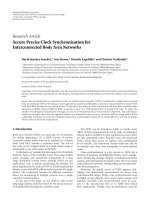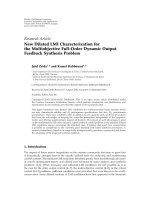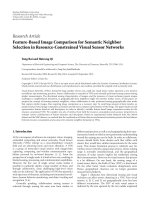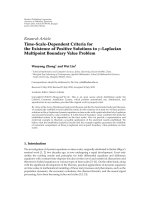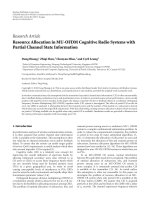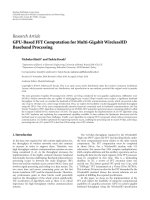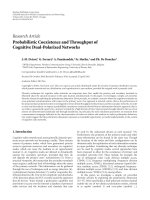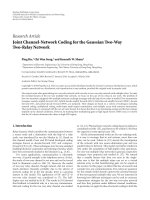Báo cáo hóa học: " Research Article Resource Partitioning with Beamforming for the Decode-Forward Relay Networks" ppt
Bạn đang xem bản rút gọn của tài liệu. Xem và tải ngay bản đầy đủ của tài liệu tại đây (619.33 KB, 6 trang )
Hindawi Publishing Corporation
EURASIP Journal on Wireless Communications and Networking
Volume 2008, Article ID 853164, 6 pages
doi:10.1155/2008/853164
Research Article
Resource Partitioning with Beamforming for
the Decode-Forward Relay Networks
Duckdong Hwang, Junmo Kim, and Sungjin Kim
Communication and Network Laboratory, Samsung Advanced Institute of Technology, Mt. 14-1, Nongseo-Dong,
Giheung-Gu, Yongin-Si, Gyeonggi-Do 446-712, South Korea
Correspondence should be addressed to Duckdong Hwang,
Received 22 May 2007; Revised 19 September 2007; Accepted 13 December 2007
Recommended by Sayandev Mukherjee
A joint power and time slot partitioning scheme based on the channel status information (CSI) is proposed for networks of
multiple relays using decode and forward (DF) protocol. A set of power constraints for the famous water pouring method is
presented depending on the time slot partitioning and CSI. Optimizing the timing and the power distributions enhances the
network throughput in addition to the diversity advantage well known for the open loop relay protocols. Beamforming techniques
for the source or destination with multiple antennas are also proposed and utilized in the partitioning process.
Copyright © 2008 Duckdong Hwang et al. This is an open access article distributed under the Creative Commons Attribution
License, which permits unrestricted use, distribution, and reproduction in any medium, provided the original work is properly
cited.
1. INTRODUCTION
Due to the cost and size of mobile user terminals, the num-
ber of multiple antennas that can be mounted on them is
limited in practice. Distributed antenna systems or user co-
operation techniques (see [1–6]) have been proposed as an
alternative or supplementary technology to enhance existing
wireless links without multiple antennas on each terminal.
The diversity enhancement capability of cooperative relaying
has been the main concern of the research community for
the last few years (see [2–6]). In support of this approach,
the popular amplify-forward (AF) and DF protocols were in-
troduced in [3].
Because of the half duplex constraint, it is anticipated
that a loss in the throughput of a relay network is inevitable
compared to the direct transmission. (The source uses only
the half of its transmission time.) This is demonstrated in
the diversity-multiplexing tradeoff (DMT)analysisofrelay-
ing protocols [2], where the diversity is shown to be ac-
quired at the expense of throughput loss. Azarian et al. pro-
pose the dynamic decode-forward (DDF) protocol to recover
the throughput loss in DF protocol [7] by allowing the size
of relay cooperation phase to vary adaptively depending on
the channel status information (CSI) of the source-to-relay
channel.
When the CSI is available at the transmitter in the closed
loop systems, we can further optimize resources of the relay-
ing networks to enhance not only the diversity but also the
throughput. (In practice, only quantized CSI is available at
the transmitter due to the bandwidth limitation of feedback
channels. Thus, the full CSI assumption is the limiting case
when the feedback channels expand their bandwidth to in-
finity. In [8], it is shown that the performance of AF relay
power control with full CSI can be approached with small
amount of feedback information. We leave the analysis of
finite feedback effect in DF resource partitioning for future
work.) In [8], a set of power allocation techniques for the AF
relaying is considered for the full and finite feedback strate-
gies. Optimization of power distribution in the symbol er-
ror sense is considered for the AF relay networks [9]andDF
relay [5] networks, respectively. The authors in [10]present
power allocation techniques for the relay protocols based on
the long-term statistics of CSI. Instant CSI-based approach is
taken in [11], where the power and the time slot are jointly
optimized for the DF relays.
As shown in [7], the time slot partitioning based on CSI
is crucial in targeting the throughput enhancement. In this
paper, we try to show that appropriate partitioning of the re-
sources (power and time slots) enhances the diversity and the
throughput of DF relaying system at the same time. Contrary
2 EURASIP Journal on Wireless Communications and Networking
to [11], where only the relay-to-destination link is consid-
ered, we consider the combined link of source-to-destination
and relay-to-destination links. Consequently, the resulting
optimization applies the famous water pouring method with
different power constraints depending on the time slot divi-
sion and CSI. The best time slot division with the maximum
mutual information is searched along with the power allo-
cation for that specific time division. As a way to quantify
the throughput enhancement by the resource partitioning,
the probability of choosing relay cooperation over the direct
transmission is analyzed and compared to that of DDF pro-
tocol in [7]. To cover more general settings, we consider the
multiple relay case and the multiple antenna case as well. For
the multiple relay case, it is shown that the resource parti-
tioning based on relay selection is enough to find the best
relaying configuration. When multiple antennas are used at
the source, we propose a way to combine beamforming with
the resource partitioning proposed.
After introducing system model in Section 2,resource
partitioning with multiple relays and analysis of the relay-
ing probability are presented in Section 3. The method to
combine beamforming with the resource partitioning is pre-
sented in Section 4. We analyze and present the simulation
results in Section 5. Section 6 concludes this paper.
2. SYSTEM MODEL
The system model and channel gains (h
i,j
) of the relay net-
work are shown in Figure 1. In the DF protocol, the source
sends the information toward the destination with power P
s
during the first time slot (T
1
). The jth relay overhears this
transmission. If it succeeds in decoding the message, it then
re-encode the message with an independent code-book and
transmits with power P
r,j
during the second time slot (T
2
).
Otherwise, the relay remains silent. Note time slot T is di-
vided such that T
1
+ T
2
= T to support the source and re-
lay transmissions. The destination leverages the observations
from the two time slots to make the final decision of the RT
bits of information sent.
Let us denote the distance of each link by d
i,j
.The
channel gains are assumed to be Rayleigh distributed with
E[γ
i,j
] = 1/d
α
i,j
.(Theexponentα denotes the path loss ex-
ponent. This is set to 2 in the simulations in Section 5.) The
power of the additive noise at the relay and destination is as-
sumed to be 1.
3. RESOURCE PARTITIONING AND
RELAYING PROBABILITY
With full CSI at hand and M DF relays, we have an event
space D of 2
M
non overlapping elements, that is, 0th event
corresponds to direct transmission with no relay cooperation
and (2
M
− 1)th event corresponds to full cooperation with
M relays. Finding the optimum resource partitioning in each
event and selecting the best choice among these event set
gives the optimum resource allocation. We will see that this
2
M
search space can be reduced to M + 1. The outage is de-
fined to be the event when the mutual information from the
source to the destination falls below the given rate. With the
Relay 2
Relay 1
Relay M
Source
Destination
h
2,1
h
1,1
h
2,2
h
2,M
h
1,2
h
1,M
h
0
.
.
.
Figure 1: The DF relay network model.
power constrain P, we find the resource partitioning which
minimizes the outage probability at the given rate R.
3.1. Resource partitioning
Let D
i
denotes the set of active relays in the ith event (i =
0, 1, ,2
M
− 1). If γ
0
=|h
0
|
2
and γ
k, j
=|h
k, j
|
2
, k = 1, 2,
j
= 1, 2, , M, then the ith event is supported when all
the links from the source to the relays in D
i
have the mu-
tual information greater than 2
RT
. Otherwise, this event is
discarded from further consideration. This condition is de-
scribed mathematically as
T
1
log
2
1+γ
1,j
P
s,i
≥ RT ∀ j ∈ D
i
⇐⇒ P
s,i
≥
2
R/μ
− 1
γ
min
,
(1)
where μ
= T
1
/T, μ ∈ (0,1]; γ
min
= min [γ
1,j
, j ∈ D
i
]and
the source power P
s,i
and μ for the itheventwillbedeter-
mined later. Note that γ
min
< (2
R
− 1)/P
s,i
is the condition
when the ith event is discarded from the consideration.
Suppose the relays in D
i
are not in outage, then the mu-
tual information from the source to the destination is
I
P
i
, μ | D
i
=
μ log
2
1+γ
0
P
s,i
+(1− μ)log
2
1+
j∈D
i
γ
2,j
P
r,j
,
(2)
where P
i
= (P
s,i
, P
r,j
, j ∈ D
i
). (Authors in [2] used orthogo-
nal space-time block coding among the relays in the set D
i
so
that the multipaths from the relays can be coherently com-
bined at the destination, which results in the mutual infor-
mation of MISO channels as in the last logarithm expression
of (2). Note the coherent combining of the MISO channel
multipaths can also be done by precoding.) The last term
in (2) can be maximized by allocationg all the relay power
Duckdong Hwang et al. 3
P
r
=
j∈D
i
P
r,j
to the one with the best link to the destina-
tion (γ
max
= max
j∈D
i
[γ
2,j
]). Thanks to this condition, we
care for only the link toward this relay from the source not to
be in outage and do not mind the links toward other relays
in D
i
. Thus, the search over 2
M
event space can be reduced to
the size M + 1 space if we consider the events with only one
relay helping the source. For each event, we find the resource
distributions which maximize the throughput.
Let E
i
, i = 1, , M be the event when the ith relay is
helping the source transmission and E
0
be the event no relay
is helping the source transmission. Then, we have
I
P
i
, μ|E
i
=
μ log
2
1+γ
0
P
s,i
+(1− μ)log
2
1+γ
2,i
P
r
.
(3)
Note that in E
0
, μ = 1andI = log
2
[1 + γ
0
P]. Given μ with
the power constraints (1)andμP
s,i
+(1− μ)P
r
= P,(3)is
known to be maximized by water pouring method. Thus, the
optimal power distribution when t(μ)
= (2
R/μ
− 1)/γ
1,i
is
P
s,i
=
1
−
1
γ
0
+
t(μ)
, P
r
=
1
−
1
γ
2,i
+
0
,(4)
where is the Lagrange multiplier and (x)
+
t
:= max (x, t). By
substituting P
s,i
= 1/−1/γ
0
, P
r
= 1/−1/γ
2,i
into the power
constraint μP
s,i
+(1− μ)P
r
= P,wehave
1
= P +
μ
γ
0
+
1
− μ
γ
2,i
,(5)
which leads to the following power distribution
P
s,i
(μ) = P +(1− μ)
γ
0
− γ
2,i
γ
0
γ
2,i
, P
r
(μ) = P − μ
γ
0
− γ
2,i
γ
0
γ
2,i
.
(6)
The channel condition and μ determines which combina-
tion of thresholds (t(μ) and 0) in (4) is applied. Depending
on these combinations and CSI, we divide the power distri-
bution scenario into the following four cases.
(1) When P
r
(μ) = 0(i.e.,1/γ
2,i
− 1/γ
0
≥ P/μ), then it is
forced to be μP
s,i
= P. The maximum mutual information is
I
= log
2
(1 + γ
0
P) when μ = 1. This case is equivalent to the
0th event and is dismissed from further consideration.
(2) When P
s,i
= t(μ)(i.e.,1/γ
2,i
− 1/γ
0
≤ (t(μ) − P)/(1 −
μ)) and P>μt(μ), the mutual information is given as
I
= μ log
2
1+γ
0
t(μ)
+(1− μ)log
2
1+
γ
2,i
1 − μ
P − μt(μ)
.
(7)
(3) When both P
s,i
= t(μ)andP
r
(μ) = 0 are satisfied at
the same time (i.e., P(1
−μ)/μ ≤ t(μ)−P ⇐⇒ P ≤ μt(μ)), then
the condition P
r
(μ) = 0 dominates the condition P
s,i
= t(μ).
Hence, μ
= 1 is forced and the case is dismissed as in the first
case.
(4) Otherwise, the mutual information is
I
= μ log
2
1+γ
0
P
s,i
(μ)
+(1− μ)log
2
1+γ
2,i
P
r
(μ)
.
(8)
With the third case, the interval (0, 1] of μ is divided into two
sections (0, μ
1
)and[μ
1
,1] with P = μ
1
t(μ
1
); the first sec-
tion, where the condition P
≤ μt(μ)ismet,isdiscarded.The
condition for the first case also divides the interval into two
sections (0, μ
2
]and(μ
2
,1]withμ
2
= P(γ
0
γ
2,i
/(γ
0
− γ
2,i
)); the
second section is the region discarded this time. The con-
dition μ
2
≤ μ
1
makes all the values of μ ∈ (0, 1] to be
trapped in the first or the third case and the event E
i
is dis-
missed. Otherwise, the condition for the second case divides
the remaining interval into two sections [μ
1
, μ
3
]and(μ
3
, μ
2
]
with t(μ
3
) = P +(1− μ
3
)((γ
0
− γ
2,i
)/γ
0
γ
2,i
); (7)isusedfor
μ
∈ [μ
1
, μ
3
]and(8)isusedforμ ∈ (μ
3
, μ
2
]tofindμ that
maximizes the mutual information for the event E
i
. This pro-
cess is repeated for all E
i
, i = 0, 1, , M and the best re-
source partitioning among the M + 1 events is found. If the
maximum mutual information does not support the rate R
with the power constraint P, then the channel is in outage. As
a baseline system, we consider the case where μ is confined to
be in the set
{1, 1/2}.
3.2. Relaying probability
While open loop DF protocol trades the throughput with
the diversity gain (see [2]), the DMT analysis of DDF pro-
tocol in [7] shows that it achieves the diversity without much
throughput loss compared to DF protocol. Hence in this
subsection, we compare the proposed scheme with DDF in
throughput aspect.
The DDF protocol tries to control the cooperation phase
without power control, hence it seems that the DDF per-
forms worse than the proposed scheme in this paper. But, the
source in the DDF protocol continues the transmission dur-
ing the time the relays cooperate, which is an advantage over
the proposed system. Since the proposed system outperforms
both the source-to-destination direct link and the conven-
tional DF protocol where μ is fixed to 1/2, the union of DMT
curves of these protocols lower bound that of the proposed
system. On the other hand, it is obvious that the proposed
scheme performs worse than MISO or SIMO links with M+1
antennas since these correspond to perfect source-to-relay
channels or relay-to-destination channels respectively. Thus,
DMT curves of these links upper bound that of the proposed
scheme. From this observation, we can conclude that the
proposed joint time slot and power partitioning introduces
the diversity advantage without sacrificing the throughput.
In another view, the probability that E
i
, i
/
= 0 are se-
lected quantifies how much the relaying contributes to this
throughput enhancement. In Section 3, it is shown that a re-
lay cooperates when two independent events
{γ
0
≤ γ
2,i
/(1 −
Pγ
2,i
/μ)}, {γ
1,i
≥ (2
R
− 1)/P} occur at the same time. The
probability that at least a relay among M relays cooperates
with the time slot partitioning μ is
P
c
(μ) =
M
i=1
Pr
γ
0
≤
γ
2,i
1 − Pγ
2,i
/μ
Pr
γ
1,i
≥
2
R
− 1
P
.
(9)
4 EURASIP Journal on Wireless Communications and Networking
Supposing that γ
0
, γ
1,i
and γ
2,i
are Chi-square dis-
tributed with degree 2 and λ
i
being the statistical average of
γ
i
, then we have the following lower bound:
Pr
γ
0
≤
γ
2,i
1 − Pγ
2,i
/μ
≥
μ/2P
0
∞
γ
0
f
γ
(γ)dγ +
∞
μ/2P
∞
γ
0
/4+4μ/P
f
γ
(γ)dγ
=
λ
2,i
λ
0
+ λ
2,i
1 − exp
−
μ(λ
0
+ λ
2,i
)
2λ
0
λ
2,i
P
+
4λ
2,i
λ
0
+4λ
2,i
exp
−
μ(33λ
0
+4λ
2,i
)
8λ
0
λ
2,i
P
≈
μ
2P
+
8λ
0
λ
2,i
P − μ(33λ
0
+4λ
2,i
)
2λ
0
(λ
0
+4λ
2,i
)P
,
(10)
where we used the two tangential lines of γ
0
= γ
2,i
/(1 −
Pγ
2,i
/μ)atγ
2,i
= 0andγ
2,i
= μ/(2P) for the lower bound-
ing. The approximation holds at high SNR. Sending P
→∞
allows us to send μ
1
, the minimum value of μ in the saved
section, to 0. Then, P
→∞and μ → 0send(10)to
4λ
2,i
λ
0
+4λ
2,i
. (11)
Consider the DDF protocol [7], where the source and re-
lay power are fixed as P
s,i
= P
r
= P and the system con-
trols μ for the minimum outage transmission. In this case,
the cooperation of the ith relay is selected if the conditions
{γ
0
≤ γ
2,i
} and {γ
1,i
≥ (2
R
− 1)/P} occur at the same time
with μ
= R/log
2
(1 + γ
1,i
P). Then, we have
Pr
γ
0
≤ γ
2,i
=
λ
0
λ
0
+ λ
2,i
. (12)
Comparing this to (11) and assuming λ
2,i
λ
0
,(11)ismuch
closer to 1 than (12).
Compared to the fixed time slot case where μ is confined
to be in the set
{1, 1/2}, we can certainly find better μ with
larger cooperation probability than μ
= 1/2. These analysis
show that the joint partitioning of time slot and power has
larger cooperation probability than the partitioning of indi-
vidual resource only, thus contributes to the throughput en-
hancement.
4. BEAMFORMING
Recent developments show that multiple antenna technology
is the key ingredient in enhancing the wireless communi-
cation performance. Therefore, we expect further enhance-
ment of relaying networks by exploiting the beamforming
gain from multiple antennas. In this section, we propose
methods to combine beamforming and resource partition-
ing in Section 3 when multiple transmit antennas are used at
the source or at the destination. First, we assume N transmit
antennas at the source and single antenna for the relays and
the destination. The channel gains h
0
, h
1,j
, j = 1, , M are
N-dimensional vectors and h
2,j
, j = 1, , M are scalars.
h
0
h
1,i
1 − λ
2
h
0
λ
h
⊥
0
θ
θ
p
Figure 2: The p,
h
0
,and
h
1,i
vectors.
Cumulative probability
Throughput (bps/Hz)
No relay
Power control
Power + timeslot
Beamforming
0123456
0
0.1
0.2
0.3
0.4
0.5
0.6
0.7
0.8
0.9
Figure 3: The cumulative distributions of mutual information in
different resource partitioning schemes when two relays are placed
in the middle of the source and the destination nodes. Two antennas
at the source are used in the beamforming.
Suppose p, |p|=1 is the beamforming vector applied
at the source and E
i
is the event being considered. We have
t(μ)
= (2
R/μ
− 1)/(γ
1,i
|p
+
h
1,i
|
2
), where γ
1,i
=|h
1,i
|
2
when a =
a/|a|. The mutual information for this event is given as
I
P
i
, μ|E
i
= μ log
2
1+γ
0
p
+
h
0
2
P
s,i
+(1− μ)log
2
1+γ
2,i
P
r
.
(13)
From the condition for the third case in Section 3,itiseasyto
see that μ
3
is decreased if |p
+
h
1,i
| increased. Since (μ
3
, μ
2
]is
the interval with a weakest constraint, we can, obviously, ex-
pect better outage performance with a wide second section.
Also, increasing
|p
+
h
0
| contributes for the better mutual
Duckdong Hwang et al. 5
−3
−2.5
−2
−1.5
−1
−0.5
0
No relay
Power control
Power + timeslot
024681012
Log(probability outage)
P/N
0
(dB)
(a)
0
−0.1
−0.2
−0.3
−0.4
−0.5
−0.6
−0.7
−0.8
−0.9
No relay
Power control
Power + timeslot
Log(probability outage)
P/N
0
(dB)
0510
(b)
Figure 4: Outage probability plots of resource partitioning schemes; (a) when R = 1bps/Hz, (b) when R = 3bps/Hz; one relay is used.
information in (8). Thus, p should be jointly matched to
h
1,i
and
h
0
.
The vector
h
1,i
can be decomposed as
h
1,i
=
1 − λ
2
h
0
+ λ
h
⊥
0
= cosθ
h
0
+sinθ
h
⊥
0
, (14)
where
h
⊥
0
is perpendicular to
h
0
.Ifwesetp = cosθ
h
0
+
sin θ
h
⊥
0
,0≤ θ ≤ θ, the vector p is positioned between
vector
h
0
and vector
h
1,i
as shown in Figure 2 and we have
|p
+
h
0
|=cosθ and |p
+
h
1,i
|=cos(θ − θ). This parametriza-
tion gives t(μ)
= (2
R/μ
− 1)/[γ
1,i
cos
2
(θ − θ)] and
I
P
i
, μ|E
i
=
μ log
2
1+γ
0
cos
2
θP
s,i
+(1− μ)log
2
1+γ
2,i
P
r
.
(15)
Optimum point in the parameter space determined by μ
∈
(0, 1] and θ ∈ [0, θ] is to be searched with the four cases as
in Section 3 depending on these parameter values.
When there are N receive antennas at the destination
and single antenna for the relays and the source, the chan-
nel gains h
0
, h
2,j
, j = 1, , M are N-dimensional vectors
and h
1,j
, j = 1, , M are scalars. Since the source and relay
transmissions use orthogonal channels in time, we can apply
different receive beamforming vectors (p) for these transmis-
sions. In the event E
i
, p = h
0
is applied for the source trans-
mission and p
= h
2,i
is applied for the relay transmission.
5. SIMULATION
In Figure 3, the cumulative distributions of mutual in-
formation corresponding to different resource partitioning
schemes are plotted. The signal to noise ratio (P/N
0
)isset
to 10 dB. For the time slot partitioning, we quantize μ
∈
(0, 1] into 10 uniform length regions, the quantized values
of which are tested for the maximum mutual information
with appropriate power allocation as in Section 3. For the
beamforming, the angle θ
∈ [0, θ] is quantized into 4 uni-
form regions. Hence, 10
× 4 quantized regions are tested for
the set of μ and θ. Note the power only control case corre-
sponds to 2-level quantization, hence is different from open
loop scheme because it relies on CSI and chooses μ
= 1, that
is, the direct source-to-destination link, according to the con-
ditions in Section 3. With power allocation only, more than
three-fold increase in the rate is observed with 10
−1
outage
probability. Joint power and time slot partitioning gives ad-
ditional 0.5 bps and the beamforming gives another 0.5bps
at the same outage probability.
Theoutageprobabilitiesofdifferent schemes against the
SNR (P/N
0
)areplottedinFigure 4. Besides that the num-
ber of relays is one, all the conditions are the same as in
Figure 3. The slopes of the curves represent the diversity or-
der enhancement from the relaying. As shown in Figure 4(a),
the resource partitioning schemes give additional power gain
over the transmission scheme without relay. As the rate (R)
6 EURASIP Journal on Wireless Communications and Networking
increases from 1 bps/Hz to 3 bps/Hz, the benefit of partition-
ing time slot becomes prominent.
6. CONCLUSION
We present a joint time slot and power partitioning scheme
along with a beamforming strategy for the network with
multiple DF relays possibly with multiple antennas at the
source or destination. Based on the CSI information, the pro-
posed scheme further enhances the throughput as well as
the diversity advantage known in open loop relay networks.
The analysis of relaying probability indicates the enhance-
ment from the resource partitioning. Supporting simulation
results are presented.
REFERENCES
[1] A. Sendonaris, E. Erkip, and B. Aazhang, “User cooperation
diversity. Part I. System description,” IEEE Transactions on
Communications, vol. 51, no. 11, pp. 1927–1938, 2003.
[2] J. N. Laneman and G. W. Wornell, “Distributed space-time
coded protocols for exploiting cooperative diversity in wireless
networks,” IEEE Transactions on Information Theory, vol. 49,
no. 10, pp. 2415–2425, 2003.
[3] J.N.Laneman,D.N.C.Tse,andG.W.Wornell,“Cooperative
diversity in wireless networks: efficient protocols and outage
behavior,” IEEE Transactions on Information Theory, vol. 50,
no. 12, pp. 3062–3080, 2004.
[4] M. Janani, A. Hedayat, T. E. Hunter, and A. Nosratinia,
“Coded cooperation in wireless communications: space-time
transmission and iterative decoding,” IEEE Transactions on
Signal Processing, vol. 52, no. 2, pp. 362–371, 2004.
[5] G. Scutari and S. Barbarossa, “Distributed space-time coding
for regenerative relay networks,” IEEE Transactions on Wireless
Communications, vol. 4, no. 5, pp. 2387–2399, 2005.
[6] A. Stefanov and E. Erkip, “Cooperative coding for wireless net-
works,” IEEE Transactions on Communications, vol. 52, no. 9,
pp. 1470–1476, 2004.
[7] K. Azarian, H. El Gamal, and P. Schniter, “On the achiev-
able diversity-multiplexing tradeoff in half-duplex cooperative
channels,” IEEE Transactions on Information Theory, vol. 51,
no. 12, pp. 4152–4172, 2005.
[8] N. Ahmed, M. A. Khojastepour, A. Sabharwal, and B.
Aazhang, “Outage minimization with limited feedback for the
fading relay channel,” IEEE Transactions on Communications,
vol. 54, no. 4, pp. 659–669, 2006.
[9] P. A. Anghel and M. Kaveh, “On the performance of dis-
tributed space-time coding systems with one and two non-
regenerative relays,” IEEE Transactions on Wireless Communi-
cations, vol. 5, no. 3, pp. 682–692, 2006.
[10] R. Annavajjala, P. C. Cosman, and L. B. Milstein, “Statistical
channel knowledge-based optimum power allocation for re-
laying protocols in the high SNR regime,” IEEE Journal on Se-
lected Areas in Communications, vol. 25, no. 2, pp. 292–305,
2007.
[11] E. G. Larsson and Y. Cao, “Collaborative transmit diversity
with adaptive radio resource and power allocation,” IEEE
Communications Letters, vol. 9, no. 6, pp. 511–513, 2005.


